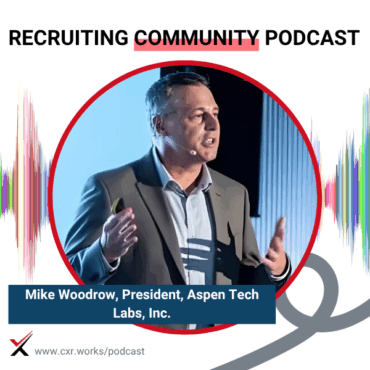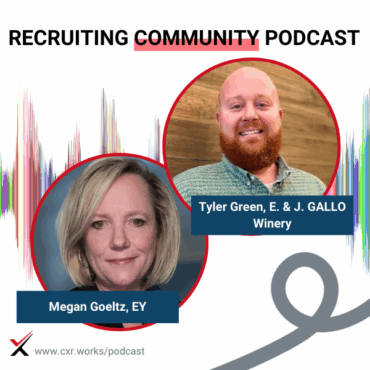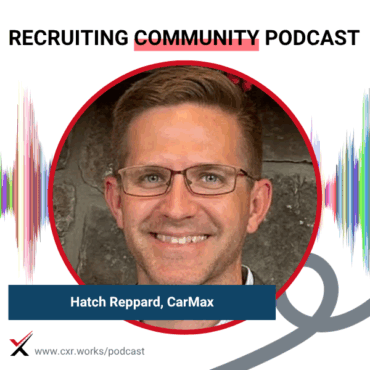
Candidate Use of AI
Are candidates cheating with AI—or just keeping up? CarMax’s Hatch Reppard joins us to unpack the gray areas in AI-assisted interviews and how employers are responding.
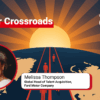 play_arrow
play_arrow
Balancing Strategy and Tactics: Melissa Thompson’s Career Crossroads Cami Grace
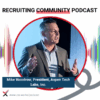 play_arrow
play_arrow
Real-Time Jobs Data and the TA Advantage Cami Grace
 play_arrow
play_arrow
20+ Years at Dell and Beyond: Jennifer Newbill’s Career Crossroads Cami Grace
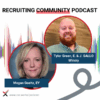 play_arrow
play_arrow
AI Interview Research Cami Grace
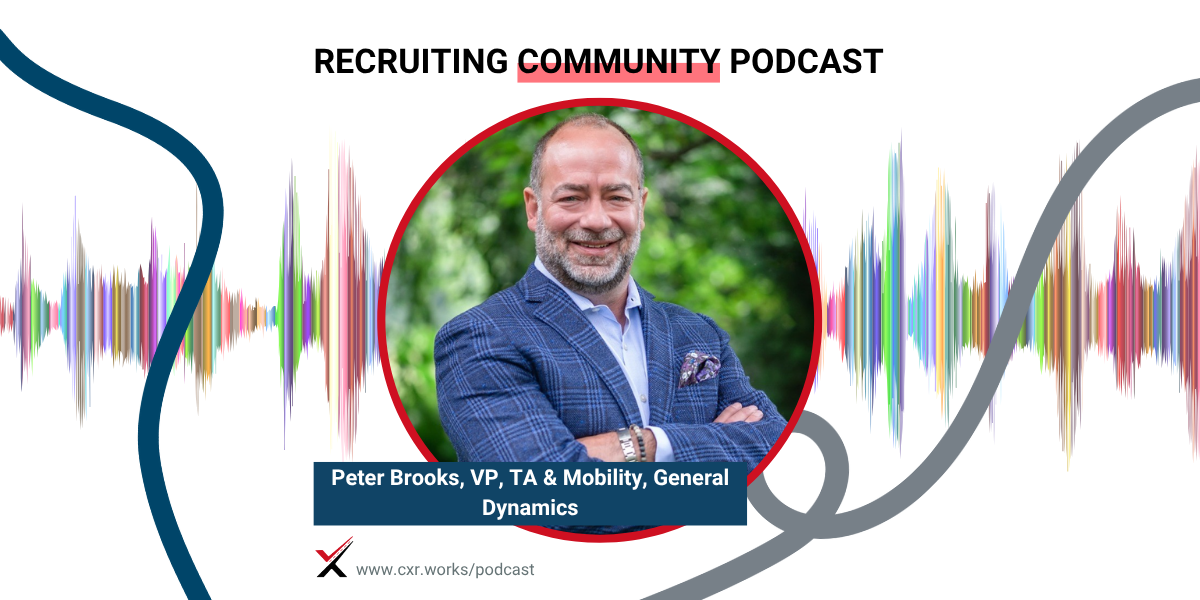
Episode Overview:
This episode explores the intersection of employee referral programs and employer brand advocacy, challenging the traditional separation of these two strategies. Sam Davies, CEO of RealLinks, shares his journey and insights on how merging these approaches can lead to increased employee engagement and better results for talent acquisition.
Key Topics Covered:
Closing Notes:
Peter gives an optimistic reminder: “There’s no better time to be alive than right now.” Despite the challenges of change, this era offers unparalleled opportunities for growth, innovation, and purpose-driven work.
Title:
Positioning TA for What’s Next
Featured Guests:
Peter Brooks, Vice President of Talent Acquisition and Mobility, General Dynamics Information Technology (GDIT)
Hosts:
Chris Hoyt, President, CareerXroads
Gerry Crispin, Principal and Co-founder, CareerXroads
Episode Overview:
Peter Brooks returns to the CXR podcast to explore how recruiting can evolve in the face of accelerating business velocity and AI-driven change. With nearly three decades in TA leadership, Peter shares practical insights on integrating automation, building inclusive pipelines, aligning with business strategy, and upskilling recruiters into true talent advisors. The discussion emphasizes how recruiters can expand their impact—if they’re willing to adapt.
Key Topics:
Tailoring AI and automation by role type and hiring process
Reducing administrative tasks to free up recruiters for strategic work
Making diversity planning actionable through integrated ATS data
Building business fluency and talent advisor capabilities in TA teams
Retaining underrepresented talent through tailored support programs
Creating compelling business cases for TA technology investments
How AI will continue to change speed, scale, and recruiter responsibilities
The human element: trust-building, cultural fit, and long-term talent strategy
Notable Quotes:
“The velocity of business has never been this fast—and will never be this slow again.” — Peter Brooks
“Let the machines handle repetitive tasks so humans can align talent strategy to business outcomes.” — Peter Brooks
“Recruiters need to have business conversations—not just HR conversations.” — Peter Brooks
“Different people need different support as they acclimate. If you provide it, you’ll retain that talent.” — Peter Brooks
“Work is about more than just a paycheck. It’s about purpose.” — Peter Brooks
Takeaways:
AI is reshaping the pace and priorities of recruiting, but humans remain essential to success. TA leaders must embrace automation, not to replace recruiters—but to enable them to focus on advising, building equity, and shaping the workforce of the future. The best-prepared teams will be those who adapt early and build strategic skills now.
Want more conversations like this?
Subscribe to the CXR podcast and explore how top talent leaders are shaping the future of recruiting. Learn more about the CareerXroads community at cxr.works.
Chris Hoyt: So we’re back, everybody. We’re back from Thanksgiving. We were just talking about that really quickly and I can’t not share. So I guess my question is—everybody—what did we do for Thanksgiving? Peter, did you have a hundred people at your house?
Peter Brooks: You know, we had a very low-key but family-oriented Thanksgiving. We had the in-laws and some immediate family with the kids all together. Low key. We actually had the meal catered, which took the stress level way down. It was just a nice, enjoyable holiday.
And I’ll tell you what—I think it’s the season, but what better time to give gratitude for your family, friends, loved ones, and blessings? So yes, I had a very enjoyable week last week.
Chris Hoyt: I love it. Congrats on a smooth family holiday.
Gerry Crispin: Yeah.
Chris Hoyt: And Jerry, how about yourself? Any of your 400 relatives gather?
Gerry Crispin: Only 25 on the block, but another 50 or so within a couple miles. I love the idea—because of my age—while I love to cook turkey and all the sides, it’s starting to get to be a chore. I like the idea of catering so that, like Peter, it’s easier to be more grateful than stressed.
Peter Brooks: Exactly. We all had a couple of favorites that we thought were worth doing the homemade version of. Stuffing, for example, and dinner rolls my mother-in-law made. So we had the personal touch, but a lot of the heavy lifting was outsourced.
Gerry Crispin: I love the potluck. We do that on Friday. We ask our cousins to bring either a leftover appetizer or a leftover dessert because there’s always a lot of those. So we ask them to show up on Friday evening. I try to tend the bar—it’s in my grandfather’s house he built in 1920. The theme is “come back to where we came from.” We had 70 people. It’s not a big house, so it bursts at the seams, but it’s a way to catch up with people you may not see every day.
Chris Hoyt: That’s beautiful. I love it. Well, let’s talk about the future. You guys ready to get started?
Peter Brooks: Let’s do it.
Gerry Crispin: Let’s go.
Announcer: Welcome to the CXR channel—our premier podcast for talent acquisition and talent management. Listen in as the CXR community discusses a wide range of topics focused on attracting, engaging, and retaining the best talent. We’re glad you’re here.
Chris Hoyt: Welcome, everybody, to the Recruiting Community Podcast Show. We do weekly insights and updates in the form of conversation. I’m your host as we move into the second part of the holiday season in the United States. And with me—nickel, nickel, and nickel. That’s us! I thought you’d appreciate that, Jerry.
Today, we’re talking business velocity. It’s never been this fast—and we suspect it’s never going to be this slow again. In addition to change happening at a breathtaking pace—and likely speeding up even more with all the AI buzz—how should recruiting be harnessing this opportunity to expand its impact on the business?
So today, we’ve got longtime friend Peter Brooks of GDIT. We’re talking AI, role changes, creating a representative workforce, and building the competencies recruiters need for sustainable careers.
A little housekeeping first: we’re streaming on YouTube, Facebook, LinkedIn, Twitch. You can visit cxr.works/podcast for past and future episodes. If you’re with us live on LinkedIn, say hi in the chat, introduce yourself, and drop in any questions for us or our guest.
And remember, this is an ad-free labor of love—but we do have a plug. We just released a new research report, some downloadable content, and two blogs in a new series. Check it all out at cxr.works/research.
Jerry, anything you want to add?
Gerry Crispin: No, no. That was fine.
Chris Hoyt: Okay. Then let’s welcome our guest. Peter, welcome back—great to see you!
Peter Brooks: Great to see you guys. Last time we were all on a podcast together, we were doing a whiskey tasting! This one is right around noon here on the East Coast, so it’s entirely sober. Great to be here.
Chris Hoyt: Was it Oban?
Peter Brooks: Yes, that’s right. Good memory!
Chris Hoyt: I remember. I like a good drink. Now you’re making my liver growl—and it’s not even lunch yet.
Peter is VP of Talent Acquisition and Mobility at General Dynamics Information Technology (GDIT). Prior to that, he was VP of TA at Protiviti and before that, VP of TA at Northrop Grumman. If memory serves, he’s a poli-sci thinker and a design-thinking doer. We’ve loved this guy for years. But Peter, give us your escalator pitch—who is Peter Brooks and why are we listening to you today?
Peter Brooks: Like many of my peers, I started in TA before I knew it was a profession. I spent about 10 years in TA, moved into consulting and business development, but I realized I loved the talent angle.
You’re at the pointy end of the spear when it comes to company growth. You’ve got access to execs who care deeply about their business sustainability and the talent required. I love the operational cadence—it’s always on. There’s always something new to learn. The last four years have been no exception.
I’m now closing in on almost three decades in the profession. It’s been a great career and I’d love to help the next generation of TA professionals who are equally passionate about talent.
Chris Hoyt: I love that. Let’s dive in. With everything changing so fast—and AI everywhere—do you have any practical ways recruiting teams (not just leadership) can leverage that technology to make a bigger impact in their organizations?
Peter Brooks: Yeah, I sat down with my team months ago to ask how we can harness AI and automation in ways that expedite hiring, attract candidates, and reduce barriers for underrepresented groups.
The key is—it’s not one-size-fits-all. You’ve got early career, executive hiring, experienced hiring, high-volume roles. You’ve got to deconstruct each process individually and find where AI fits best.
Ultimately, it’s about equipping recruiters to take on higher-value work. Let the machines handle repetitive tasks so humans can align talent strategy to business outcomes.
Chris Hoyt: Agreed. You’ve been doing this for three decades—you’ve seen the cycles. What day-to-day recruiting activities do you think will change with AI and automation?
Peter Brooks: In the old days, recruiters learned to source and cold call. They had to really understand the business. Then we brought in digital tools—but recruiters still did admin work like setting up interviews and formatting resumes.
That admin burden has never really gone away. Today, I want recruiters out there talking to clients and candidates—not stuck in spreadsheets. Tech is perfect for those repetitive tasks.
But here’s the thing: if you don’t equip recruiters to shift into being talent advisors, the tech won’t save you. Prepare now for what’s next. Don’t wait until their skills are outdated.
Gerry Crispin: I love what you’re saying. For years, we’ve focused on just-in-time recruiting. But we need to invest in building future talent pools—like we do with interns. Especially from underrepresented groups. I think that’s where recruiting can elevate itself.
Peter Brooks: Couldn’t agree more. Inclusion and belonging have to extend to candidates too. Companies that do this well will thrive. Those that don’t will fall behind.
Post-COVID, 70% of the folks who left the labor force aren’t coming back. Fertility rates are too low. We don’t have enough talent. It’s going to take reskilling and tapping underrepresented communities in a meaningful way.
Chris Hoyt: We’re seeing that too. But with some companies pulling back on DEI, there’s concern. Regardless of political views, I believe diverse teams drive success. The studies are clear.
So how do we build a representative recruiting team? Any straightforward strategy?
Peter Brooks: As a federal contractor, we create affirmative action plans annually. The idea is—over time, with equitable hiring practices—you should reflect the communities where you operate.
Historically, these plans got shared once a year and then forgotten. I recommend integrating them into your ATS or CRM so recruiters see that data when opening a job. If you’re underrepresented in veterans, for example, it helps guide your sourcing efforts immediately.
Gerry Crispin: Transparency is key. Opening a rec should give recruiters a clear picture of what the representation looks like—so they can act on it.
Peter Brooks: Exactly. Take veterans, for instance. They return from service, and often their attrition rates are high because the private sector is such a different world.
We started a Military Transition Program at GDIT. It assigns mentors, orients them to the civilian workforce, and helps them succeed. Those who went through the program? Near-zero attrition.
Different people need different support as they acclimate. If you provide it, you’ll retain that talent.
Chris Hoyt: Love that. And it ties to how different markets have different diversity realities. Hiring in rural areas vs. major cities is just different. That nuance often gets lost.
Okay, shifting back to the future—what skills should recruiters double down on now to stay relevant?
Peter Brooks: First, build talent advisor capabilities. Gartner and John Vlastelica have great resources. We’ve upskilled our team in this area.
Recruiters need to have business conversations—not just HR conversations. They need to use TA acumen to guide hiring managers on trade-offs, skills adjacencies, and development options.
As for TA leaders: we have to build compelling business cases for tech investments. Too often, we assume the value is obvious. But you’re competing with supply chain, IT, and others for budget. Learn how to win that conversation with the CFO.
Chris Hoyt: That’s a skill in itself—and one many leaders have to learn the hard way.
Peter Brooks: Totally agree. And we tend to get siloed in our thinking. But you have to make the case in terms of broader business impact.
Chris Hoyt: Final question: what’s your prediction? How will AI keep changing recruiting and business speed?
Peter Brooks: The velocity of business has never been this fast—and will never be this slow again. Yes, people say recruiters will be replaced by tech—but we’ve heard that for decades.
Humans aren’t going anywhere. Let machines do the repetitive stuff. Free us up to do what only humans can do—build trust, drive strategy, shape culture.
And remember: work is about more than just a paycheck. It’s about purpose. As John Donahue said, “The workplace is a place where your soul can attain visibility.” Tech should amplify that—not diminish it.
Chris Hoyt: Love that. Automation hasn’t taken away the stuff we enjoy—just the stuff we’re bad at or too busy to do.
Peter Brooks: Exactly. Let the steam engine run—and let humans do what we do best.
Chris Hoyt: Last one. If you were to write a book today, what would the title be?
Peter Brooks: It’s an Exciting Time to Be Alive. Yes, the pace is exhausting. Yes, change can be daunting. But there’s no better time to be alive than right now.
Chris Hoyt: Who gets the first signed copy?
Peter Brooks: My mom. She’s my hero. She served in Vietnam, worked in mental health and physical wellbeing her whole life. I do what I do to live up to her example.
Chris Hoyt: That’s beautiful. Peter, we appreciate you so much. Have a wonderful end of the year.
Peter Brooks: You too. And special thanks to Jerry for kicking off our offsite a few months ago. Your insights fueled great dialogue with my team.
Chris Hoyt: Jerry’s making house calls! We’ll know we’ve arrived when he shows up in the Airstream.
Gerry Crispin: (laughs) Let’s do it.
Chris Hoyt: All right, everybody. Have a great rest of your week. See you next time.
Announcer: Thanks for listening to the CXR channel. Please subscribe on your favorite podcast platform and leave us a review. Learn more at cxr.works, facebook.com/careerxroads, and Instagram at @careerxroads. Catch you next time.
Tagged as: Employer Branding, Talent Acquisition, Candidate Experience, Podcast, Talent Advisor.
Chris Hoyt is the President of CareerXroads, a global peer community for talent acquisition leaders driving strategic change. With decades of experience leading recruiting innovation at Fortune 500 companies, Chris now advises enterprise TA teams on tech, process, and leadership. He’s a frequent speaker at conferences like SHRM, HR Tech, LinkedIn, and UNLEASH, and he’s known for pushing conversations beyond buzzwords to get to what really works in hiring. Through CXR, he connects top TA professionals to solve real problems, challenge norms, and shape the future of recruiting.

Are candidates cheating with AI—or just keeping up? CarMax’s Hatch Reppard joins us to unpack the gray areas in AI-assisted interviews and how employers are responding.
